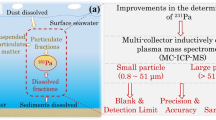Abstract
A method for the determination of barium in sea water was investigated using inductively coupled plasma emission spectrometry, and sea water samples from the Japan Sea and the Pacific Ocean were directly analyzed by this method. Artificial sea water was used to prepare matrix matched standard solutions to overcome the problem of physical interference. The detection limit (signal/noise ratio=2) for barium in deionized and distilled water was 0.08µg l−1 and in sea water, 0.12µg l−1. The reproducibilities in the purified water and in the sea water at the 10µg l−1 level were 0.7% a#FFFFFFnd 0.5%, respectively. The barium concentration in both the Japan Sea and the Pacific Ocean increased with depth and ranged between 5.5–10.0µg l−1 and 4.1–18.4µg l−1, respectively.
Similar content being viewed by others
References
Bacon, M. P. and J. M. Edmond (1972): Barium at GEOSECS III in the Southwest Pacific. Earth Planet. Sci. Lett.,16, 66–74.
Bernat, M., T. Church and C. J. Allegre (1972): Barium and strontium concentrations in Pacific and Mediterranean Sea water profiles by direct isotope dilution mass spectrometry. Earth Planet. Sci. Lett.,16, 75–80.
Chan, L. H., J. M. Edmond, R. F. Stallard, W. S. Broecker, Y. C. Chung, R. F. Weiss and T. L. Ku (1976): Radium and barium at GEOSECS stations in the Atlantic and Pacific. Earth Planet. Sci. Lett.,32, 258–267.
Chan, L. H., D. Drummond, J. M. Edmond and B. Grant (1977): On the barium data from the Atlantic GEOSECS Expedition. Deep-Sea Res.,24, 613–649.
Chow, T. J. (1976): Barium in Southern California coastal waters: A potential indicator of marine drilling contamination. Science,193, 57–58.
Church, T. M. and K. Wolgemuth (1972): Marine barite saturation. Earth Planet. Sci. Lett.,15, 35–44.
Chung, Y. (1980): Radium-barium-silica correlations and a two-dimensional radium model for the world ocean. Earth Planet. Sci. Lett.,49, 309–318.
Dehairs, F., R. Chesselet and J. Jedwab (1980): Discrete suspended particles of barite and the barium cycle in the open ocean. Earth Planet. Sci. Lett.,49, 528–550.
Fassel, V. A. and R. N. Kniseley (1974): Inductively coupled plasmas. Anal. Chem.,46, 1155A-1164A.
Gamo, T. and Y. Horibe (1983): Abyssal circulation in the Japan Sea. J. Oceanogr. Soc. Japan,39, 220–230.
Li, Y. H., T. L. Ku, G. G. Mathieu and K. Wolgemuth (1973): Barium in the Antarctic Ocean and implications regarding the marine geochemistry of Ba and226Ra. Earth Planet. Sci. Lett.,19, 352–358.
Lyman, J. and R. H. Fleming (1940): Composition of sea water. J. Mar. Res.,3, 134–146.
McLaren, J. W., S. S. Berman, V. J. Boyko and D. S. Russell (1981): Simultaneous determination of major, minor, and trace elements in marine sediments by inductively coupled plasma atomic emission spectrometry. Anal. Chem.,53, 1802–1806.
McQuaker, N. R., P. D. Kluckner and G. K. Chang (1979): Calibration of an inductively coupled plasma-atomic emission spectrometer for the analysis of environmental materials. Anal. Chem.,51, 888–895.
Miyazaki, A., A. Kimura, K. Bansho and Y. Umezaki (1982): Simultaneous determination of heavy metals in waters by inductively-coupled plasma atomic emission spectrometry after extraction into diisobutyl ketone. Anal. Chim. Acta,144, 213–221.
Nojiri, Y., H. Haraguchi and K. Fuwa (1981): Simultaneous multielement analysis of waste water by inductively coupled plasma emission spectrometry. Nippon Kagaku Kaishi, pp. 48–54.
Parsons, M. L., A. Forster and D. Anderson (1980): An atlas of spectral interference in ICP spectrometry. Plenum, New York, pp. 644.
Riley, J. P. and D. Taylor (1968): Chelating resins for the concentration of trace elements from sea water and their analytical use in conjunction with atomic absorption spectrometry. Anal. Chim. Acta,40, 479–485.
Sugimae, A. (1979): Simultaneous determination of multi elements in river water and industrial waste water by inductively coupled plasma-optical emission spectrometry. Bunseki Kagaku,28, 555–559.
Turekian, K. K. and E. H. Tausch (1964): Barium in deep-sea sediments of the Atlantic Ocean. Nature,201, 696–697.
Winge, R. K., V. J. Peterson and V. A. Fassel (1979): Inductively coupled plasma-atomic emission spectrometry: Prominent lines. Appl. Spectrosc.,33, 206–219.
Wolgemuth, K. and W. S. Broecker (1970): Barium in sea water. Earth Planet. Sci. Lett.,8: 372–378.
Author information
Authors and Affiliations
Rights and permissions
About this article
Cite this article
Sugiyama, M., Matsui, M. & Nakayama, E. Direct determination of barium in Sea water by inductively coupled plasma emission spectrometry. Journal of the Oceanographical Society of Japan 40, 295–302 (1984). https://doi.org/10.1007/BF02302522
Received:
Revised:
Accepted:
Issue Date:
DOI: https://doi.org/10.1007/BF02302522



